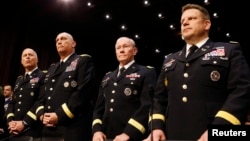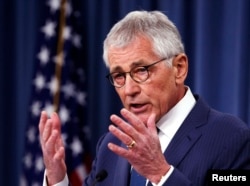Despite significant investments by the U.S. military to reduce interpersonal violence and educate service members, sexual assault continues to be a major problem in the armed forces, say researchers who gathered at Arlington National Cemetery this week.
Sexual assault is a heinous crime that devastates victims and has a far-reaching negative effect for the Department of Defense (DoD) because it undermines the department’s core values, degrades mission readiness and raises financial costs, said Brenda Farrell of the U.S. Government Accountability Office (GAO), the independent investigative arm of Congress.
Farrell said that while DoD data show that assaults on service members went from 2,800 in 2007 to 6,100 in 2014, other data suggest that “reported sexual assaults represent only a fraction of the incidents that are actually occurring in DoD."
Andrew Morral, a senior behavioral scientist at the RAND Corporation, a nonprofit policy organization, said that in early 2014 at the request of the DoD, the company assessed the rates of sexual assault, sexual harassment and gender discrimination in the military.
RAND then invited close to 560,000 active and reserve service members in the Army, Navy, Air Force and Marine Corps to participate in a survey in August and September of that year.
Morral said that “out of about 1.3 million active-component service members, an estimated 20,300 were sexually assaulted.” Approximately 1 percent of men and 4.9 percent of women among active-component service members were victims.
The RAND report also showed the risk of sexual assault varied substantially by branch of service. Men and women in the Air Force had a much lower risk.
Solving the problem
Service Women’s Action Network CEO Judy Patterson said that in order to solve the military sexual assault problem, it is critical that leaders, policymakers and individuals understand the "continuum of harm" that she said connects a broad range of deeply rooted beliefs, attitudes and behaviors that lead to sexual violence.
Morral also said the sexual assault experiences of men and women differ. “Men who are assaulted are more likely than women to experience multiple assaults, and they are more likely to be assaulted by multiple offenders during each incidence and to describe the assault as hazing," she said.
In a GAO report this year on DoD’s policies to address and track hazing of service members, Farrell said “initiation and rites of passage can be effective tools to instill loyalty among service members … such activities have at times included cruel and abusive behavior, and it hasn’t always been easy for service members to draw a clear distinction between legitimate traditions and patterns of misconduct. Sometimes hazing may cross the line into sexual assault.”
“Compared to women, men are less likely to tell anyone about the event or file a report," Morral said. "And those findings may have implications for prevention and reporting programs at DoD specifically when men are not recognizing that some of the assaults are sexual assaults and not just a form of hazing.”
Highest DoD priority
DoD insists that eliminating sexual assault remains the department’s highest priority and recognizes in its prevention strategies that prevention is more than just annual training or weekend safety briefings, former Secretary of Defense Chuck Hagel said in the DoD’s 2014-16 Sexual Assault Prevention Strategy report.
In an effort to establish shared understandings of prevention, DoD adopted the U.S. Centers for Disease Control and Prevention definition of prevention as it applies to sexual violence, including approaches that take place before sexual violence has occurred, long-term responses to address the lasting consequences of violence, and sex offender treatment intervention.
But Liz Medina, a supply administration’s specialist in the Marine Corps, said that year after year, Marines are required to participate in sexual awareness training, which she referred to as a check in a box. “Usually these are conducted before a three- or four-day weekend where they are thinking, 'As soon as I am done with this training, I am off for a long weekend.' ”
Medina said she’d like to see more support from the military leadership instead of what she described as a hostile environment that some victims, like a friend of hers, who was brutally raped in Japan, received from her unit.











